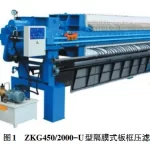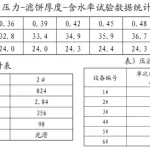As a common solid-liquid separation equipment, filter press is widely used in various industries. Discharge concentration is an important technical parameter in the use of filter press, which directly affects the quality of the final product and the extraction efficiency of the product. This article will discuss around the discharge concentration of the filter press to help readers understand its influencing factors and how to control.
I. Definition and Importance of Filter Press Discharge Concentration
The discharge concentration of the filter press refers to the proportion of solid material content in the separation process of solid and liquid materials in the filter press. The size of the discharge concentration directly affects the efficiency of the subsequent process and the quality of the product. For example, in the fields of sugar, pharmaceuticals, chemicals, etc., the level of discharge concentration often determines the purity and yield of the final product. Therefore, controlling the discharge concentration of the filter press is crucial for the stability and economic efficiency of the whole production process.
II. Factors affecting the concentration of material discharged from filter presses
1. Material nature: the nature of the material, such as particle size, density, viscosity, etc., will affect its fluidity and separation effect in the filter press process, which in turn affects the concentration of the discharged material. Generally speaking, the smaller the particles, the higher the density and the lower the viscosity of the material, the higher the discharge concentration.
2. Filter-pressing conditions: Pressure, temperature, filtration area, filtration time and other conditions during the filter-pressing process all have an effect on the concentration of the discharge material. The increase of pressure and temperature, the extension of filtration time, etc. will increase the concentration of the discharged material.
3. Performance of filter cloth: as a key element in the filter press process, the impact of its performance on the concentration of discharged material should not be ignored. The pore size, air permeability, corrosion resistance and other performance parameters of the filter cloth will affect the filtration efficiency of the material and the concentration of the discharged material.
4. Mode of operation: Mode of operation includes feed rate, feed concentration, and backwashing. The control of feed rate and feed concentration, as well as the timing and intensity of backwashing will have an impact on the concentration of the discharged material.
Third, how to control the filter press discharge concentration
1. Choose suitable filter cloth: according to the nature of the material and filtration requirements, choose the appropriate pore size and material of the filter cloth, in order to ensure good filtration effect and high concentration of the discharged material.
2. Optimising filter-pressing conditions: under the premise of ensuring the stable operation of the filter press, the pressure and temperature can be raised appropriately and the filtration time can be prolonged, so as to achieve the purpose of increasing the concentration of the discharged material. However, attention should be paid to preventing excessive increase in pressure and temperature leading to equipment damage or material deterioration.
3. Control the feed rate and feed concentration: adjust the feed rate and feed concentration according to the actual situation, maintain a stable feed state, which is conducive to improving the concentration of the discharged material. To avoid too fast feeding speed or too high concentration of feed material leading to filter cloth clogging or overloaded equipment.
4. Reasonable use of backwashing: backwashing at the right time in the filtration process can remove the residues on the filter cloth and restore its filtration performance. However, excessive backwashing should be avoided to cause wear and tear of the filter cloth or shorten its service life.
5. Monitoring and adjustment: Regularly monitor and analyse the discharge concentration of the filter press, and adjust the operating parameters in time according to the actual situation, so as to ensure the stability of the discharge concentration and compliance with the process requirements.
IV. Practical application case studies
As an example, a pharmaceutical company uses a filter press for solution separation after activated carbon adsorption. In order to improve the purity and yield of the final product, the discharge concentration of the filter press needs to be controlled. According to the actual production situation, the enterprise has taken the following measures:
1. Select filter cloth with smaller pore size, good air permeability and corrosion resistance to ensure good filtration effect;
2. Appropriately increase the pressure and temperature during the filter-pressing process and extend the filtration time in order to increase the concentration of the discharged material;
3. Control the appropriate feed rate and feed concentration to maintain a stable feed condition;
4. Backwash in due time to remove the residue on the filter cloth;
5. Regularly monitor the concentration of the discharged material and promptly adjust the operating parameters according to the actual situation.
Through the implementation of the above measures, the enterprise has succeeded in increasing the discharge consistency of the filter press, thereby improving the purity and yield of the product. This not only helps to reduce production costs, but also provides strong support for the sustainable development of the enterprise.
The discharge concentration of the filter press is an important technical parameter to measure the separation effect. In the actual production process, it is necessary to take effective measures to control the discharge concentration according to the nature of the material, filtration conditions, filter cloth performance and operation mode and other factors. By continuously optimising the operating parameters and improving the level of equipment maintenance and management, the separation efficiency can be further improved, creating greater economic and social benefits for the enterprise.
 Plate and frame chamber diaphragm filter presses
Plate and frame chamber diaphragm filter presses






